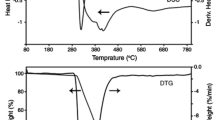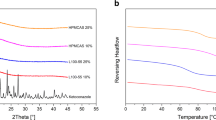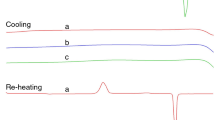Abstract
Purpose
To investigate the effect of polymer additives on the transformation of BMS-566394 anhydrate to the dihydrate form and to propose the possible mechanisms for inhibition of conversion of the anhydrate to the dihydrate form.
Materials and methods
The conversion of anhydrate to dihydrate was monitored using differential scanning calorimetry, powder X-ray diffraction and polarized light microscopy. Solubility and intrinsic dissolution studies were performed on anhydrate and dihydrate. IR and NMR spectroscopy were used to probe the molecular interactions between BMS-566394 and cellulose ether polymers.
Results
The anhydrate form of BMS-566394 was readily transformed into the more stable dihydrate form in aqueous suspension. The kinetic solubility and intrinsic dissolution rate of the anhydrate were ca. fourfold that of the dihydrate. Addition of cellulose ether polymers (HPC, HPMC, MC) inhibited anhydrate to dihydrate transformation in aqueous suspensions. Hydrogen bonding interaction between the polar groups of the drug and polymers was inferred from infrared spectroscopy. Solution NMR also indicated a hydrophobic interaction between the drug and polymer backbone.
Conclusions
The anhydrate form of BMS-566394 is stabilized in the presence of cellulose ether polymers. Spectroscopic evidence is offered to postulate a molecular interaction between drug and polymers.










Similar content being viewed by others
References
A. J. Aguiar, J. Krc, A. W. Kinkel, and J. C. Samyn. Effect of polymorphism on the absorption of chloramphenicol from chlroamphenicol palmitate. J. Pharm. Sci. 56:847–853 (1967).
N. Khalafallah, S. A. Khalil, and M. A. Moustafa. Bioavailability determination of two crystal forms of sulfameter in humans from urinary excretion data. J. Pharm. Sci. 63:861–864 (1974).
A. A. Ali and A. Farouk. Comparative studies on dissolution and the bioavailability of ampicillin anhydrate and trihydrate. Int. J. Pharm. 9:239–243 (1981).
M. Pudipeddi and A. T. M. Serajuddin. Trends in solubility of polymorphs. J. Pharm. Sci. 94(5):929–939 (2005).
R.-M. Dannenfelser, H. He, Y. Joshi, S. Bateman, and A. T. M. Serajuddin. Development of clinical dosage forms for a poorly water soluble drug I: application of polyethylene glycol-polysorbate 80 solid dispersion carrier system. J. Pharm. Sci. 93(5):1165–1175 (2004).
C. Leuner and J. Dressman. Improving drug solubility for oral delivery using solid dispersions. Eur. J. Pharm. Biopharm. 50(1):47–60 (2000).
R. K. Khankari and D. J. W. Grant. Pharmaceutical hydrates. Thermochim. Acta. 248:61–79 (1995).
M. Otsuka, N. Kaneniwa, K. Kawakami, and O. Umezawa. Effect of surface characteristics of theophylline anhydrate powder on hygroscopic stability. J. Pharm. Pharmacol. 42:606–610 (1990).
H. Zhu, C. Yuen, and D. J. Grant. Influence of water activity in organic solvent–water mixtures on the nature of the crystallizing drug phase. Part 1. Theophylline. Int. J. Pharm. 135:151–160 (1996).
M. D. Ticehurst, R. A. Storey, and W. Claire. Application of slurry bridging experiments at controlled water activities to predict the solid-state conversion between anhydrous and hydrated forms using theophylline as a model drug. Int. J. Pharm. 247:1–10 (2002).
D. R. Heidemann and P. J. Jarosz. Preformulation studies involving moisture uptake in solid dosage forms. Pharm. Res. 8:292–297 (1991).
M. Otsuka and Y. Matsuda. The effect of humidity on hydration kinetics of mixtures of nitrofurantoin anhydride and diluents. Chem. Pharm. Bull. 42:156–159 (1994).
S. Airaksinen, A. Jorgensen, J. Rantanen, and J. Yliruusi. Effects of excipients on hydrate formation in wet masses containing theophylline. J. Pharm. Sci. 92:516–528 (2003).
J. G. Kesavan and G. E. Peck. Solid-state stability of theophylline anhydrous in theophylline anhydrous-polyvinylpyrrolidone physical mixtures. Drug Dev. Ind. Pharm. 22:189–199 (1996).
Crystallographic data (excluding structure factors) for BMS-566394 dihydrate and anhydrate have been deposited with the Cambridge Crystallographic Data Centre as supplementary publication numbers CCDC 631127 & 631128. These data can be obtained free of charge via www.ccdc.cam.ac.uk/conts/retrieving.html (or from the CCDC, 12 Union Road, Cambridge CB2 1EZ, UK; fax: +44 1223 336033; e-mail: deposit@ccdc.cam.ac.uk).
S. M. Reutzel-Edens, R. L. Kleemann, P. L. Lewellen, A. L. Borghese, and L. J. Antoine. Crystal forms of LY334370 HCl: Isolation, solid-state characterization, and physicochemical properties. J. Pharm. Sci. 92(6):1196–1205 (2003).
V. Tantishaiyakul, N. Kaewnopparat, and S. Ingkatawornwong. Properties of solid dispersions of piroxicam in polyvinylpyrrolidone K-30. Int. J. Pharm. 143:59–66 (1996).
H. Sekizaki, K. Danjo, H. Eguchi, Y. Yonezawa, H. Sunada, and A. Otsuka. Solid-state interaction of ibuprofen with polyvinylpyrrolidone. Chem. Pharm. Bull. 43:988–993 (1995).
M. A. El-Hinnawi and N. M. Najib. Ibuprofen-polyvinylpyrrolidone dispersions. Proton nuclear magnetic resonance and infrared studies. Int. J. Pharm. 37:175–177 (1987).
L. S. Taylor and G. Zografi. Spectroscopic characterization of interactions between PCP and Indomethacin in amorphous molecular dispersions. Pharm. Res. 14(12):1691–1698 (1997).
M. K. Gupta, Y.-C. Tseng, D. Goldman, and R. H. Bogner. Hydrogen bonding with adsorbent during storage governs drug dissolution from solid-dispersion granules. Pharm. Res. 19(11):1663–1672 (2002).
A. P. Simonelli, S. C. Mehta, and W. I. Higuchi. Inhibition of sulfathiazole crystal growth by polyvinylpyrrolidone. J. Pharm. Sci. 59(5):633–638 (1970).
M. Otsuka, T. Ohfusa, and Y. Matsuda. Effect of binders on polymorphic transformation kinetics of carbamazepine in aqueous solution. Colloids Surf. B: Biointerfaces 17:145–152 (2000).
R. Nair, S. Gonen, and S. W. Hoag. Influence of polyethylene glycol and povidone on the polymorphic transformation and solubility of carbamazepine. Int. J. Pharm. 240(1–2):11–22 (2002).
I. Katzhendler, R. Azoury, and M. Friedman. Crystalline properties of carbamazepine in sustained release hydrophilic matrix tablets based on hydroxypropyl methyl cellulose. J. Control. Release. 54:69–85 (1998).
P. E. Luner and E. Oh. Characterization of the surface free energy of cellulose ether films. Colloids Surf. A: Physicochem. Eng. Asp. 181:31–48 (2001).
P. Kahela, R. Aaltonen, E. Lewing, M. Anttila, and E. Kristoffersson. Pharmacokinetics and dissolution of two crystalline forms of carbamazepine. Int. J. Pharm. 14:103–112 (1983).
K. K. Rajendra and D. Grant. Pharmaceutical hydrates. Thermochim. Acta. 248:61–79 (1995).
Y. Kobayashi, S. Ito, S. Itai, and K. Yamamoto. Physicochemical properties and bioavailability of carbamazepine polymorphs and dihydrate. Int. J. Pharm. 193:137–146 (2000).
P. York. Solid-state properties of powders in the formulation and procesing of solid dosage forms. Int. J. Pharm. 14:1–28 (1983).
J. W. Poole, G. Owen, J. Silverlo, J. N. Freyhof, and S. B. Roseman. Physicochemical factors influencing the absorption of the anhydrous and trihydrate forms of ampicillin. Curr. Ther. Res. 10:292–303 (1968).
G. Lafitte, K. Thureson, and O. Soderman. Mixtures of mucin and oppositely charged surfactant aggregates with varying charge density. Phase behavior, association, and dynamics. Langmuir 21:7097–7104 (2005).
P. Roussel, G. Lamblin, M. Lhermitte, N. Houdret, J. Lafitte, J. Perini, A. Klein, and A. Scharfman. The complexity of mucins. Biochimie 70no. 11, 1471–1482 (1988).
Acknowledgements
The authors wish to acknowledge Ming-Hsing Huang and Scott Huffman for their help in IR studies, Mingxin Qian for in vivo studies and Shelley Rabel for early characterization studies for the compound. The single crystal analysis was conducted by Mary Malley.
Author information
Authors and Affiliations
Corresponding author
Rights and permissions
About this article
Cite this article
Betigeri, S., Thakur, A., Shukla, R. et al. Effect of Polymer Additives on the Transformation of BMS-566394 Anhydrate to the Dihydrate Form. Pharm Res 25, 1043–1051 (2008). https://doi.org/10.1007/s11095-007-9455-5
Received:
Accepted:
Published:
Issue Date:
DOI: https://doi.org/10.1007/s11095-007-9455-5




